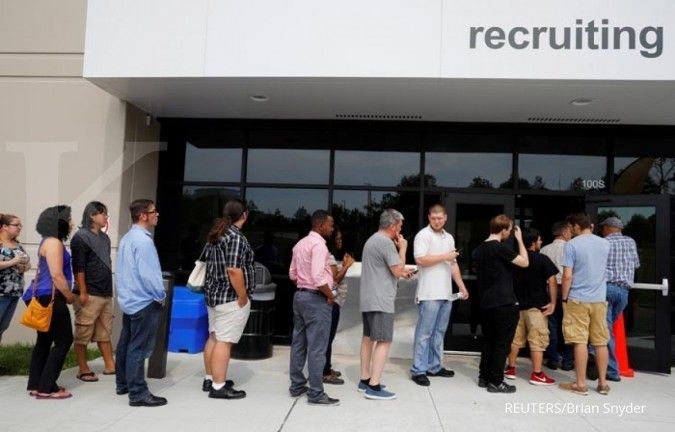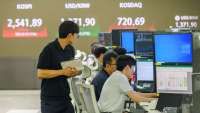MACROECONOMICS - WASHINGTON. The number of Americans filing new claims for unemployment benefits rose marginally last week, the latest suggestion that the economy was regaining some momentum as the year winds down.
The smaller-than-expected increase in weekly jobless claims reported by the Labor Department on Thursday followed recent data showing retail sales unexpectedly rising in November, while single-family housing starts and building permits scaled 1-1/2-year highs. The reports prompted economists to boost their growth estimates for the fourth quarter. The economy had shown signs of stalling at the start of the quarter.
Other data on Thursday showed a more significant cooling in inflation in the third quarter than previously reported.
"There is plenty to cheer about the economy, and next year should be even better as the Federal Reserve takes the brakes off the economy now that inflation is going their way," said Christopher Rupkey, chief economist at FWDBONDS in New York.
Initial claims for state unemployment benefits increased 2,000 to a seasonally adjusted 205,000 for the week ended Dec. 16. Economists polled by Reuters had forecast 215,000 claims for the latest week.
Read Also: Indonesia Signs a Contract to Import 500,000 tons of Rice
Unadjusted claims fell 9,225 to 239,865 last week. Filings in California dropped 3,330, while Georgia reported a 1,957 decline. Claims increased 1,167 in Ohio.
Though the claims data are volatile around this time of the year because of holidays, they remain consistent with a fairly healthy labor market, which is expected to keep the economy from recession next year. A survey from the Conference Board on Wednesday showed the share of consumers viewing jobs as plentiful was the highest in five months in December.
The claims data covered the week during which the government surveyed businesses for the nonfarm payrolls portion of December's employment report. Claims fell slightly between the November and December survey periods.
The economy added 199,000 jobs in November, fewer than the monthly average of 240,000 over the past year, but more than the 150,000 positions created in October.
The Federal Reserve held interest rates steady last week and policymakers signaled in new economic projections that the historic monetary policy tightening engineered over the last two years is at an end and lower borrowing costs are coming in 2024. Since March 2022, the U.S. central bank has hiked its policy rate by 525 basis points to the current 5.25%-5.50% range.
Read Also: Gold Range-Bound as Market Focuses on US Economic Data
UNDERLYING STRENGTH
Data next week on the number of people receiving benefits after an initial week of aid, a proxy for hiring, could shed more light on the labor market's fortunes in December. The so-called continuing claims slipped 1,000 to 1.865 million during the week ending Dec. 9, the claims report showed.
Continuing claims have mostly increased since mid-September, blamed largely on difficulties adjusting the data for seasonal fluctuations after an unprecedented surge in filings for benefits early in the COVID-19 pandemic.
Economists expect the distortion will be smoothed out when the government revises the data next year. Labor market strength is fueling consumer spending, keeping the overall economy afloat. In a separate report on Thursday, the government confirmed that economic growth accelerated in the third quarter.
Gross domestic product increased at a 4.9% annualized rate last quarter, revised down from the previously reported 5.2% pace, the Commerce Department's Bureau of Economic Analysis (BEA) said in its third estimate of third-quarter GDP.
It was still the fastest pace of expansion since the fourth quarter of 2021. Economists had expected GDP growth would be unrevised at a rate of 5.2%.
Read Also: Indonesia C.Bank Keeps Benchmark Interest Rate at 6.00%
The economy, which grew at a 2.1% pace in the second quarter, has been expanding at a pace far above what Fed officials regard as the non-inflationary growth rate of around 1.8%. The downward revision to GDP growth last quarter reflected downgrades to consumer spending and inventory investment.
Growth in consumer spending, which accounts for more than two-thirds of U.S. economic activity, was trimmed to a still-lofty 3.1% rate from the previously estimated 3.6% pace. That was largely the result of a downward revision to spending on international travel. The downgrades to spending also meant that inflation was not as hot was previously reported.
The personal consumption expenditures (PCE) price index excluding the volatile food and energy components increased at a downwardly revised 2.0% rate in the third quarter. The so-called core PCE price index was previously reported to have risen at a 2.3% pace.
The increase in private inventory investment was lowered to a $77.8 billion rate from the previously reported $83.9 billion rate, mostly reflecting downgrades to stocks at general merchandise and other retail stores.
Though the economy is settling into a more moderate growth path this quarter, the pace likely remains enough to fend off a recession. Growth estimates for the fourth quarter range from as low as a 1.1% rate to as high as a 2.7% pace.
In addition to slower consumer spending, growth this quarter is expected to be restrained by a wider trade deficit and slower pace of inventory building relative to the third quarter.
/2019/02/12/497173632p.jpg)












